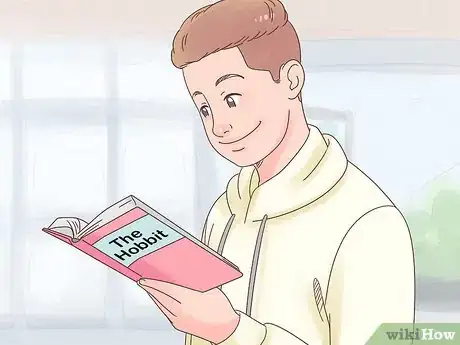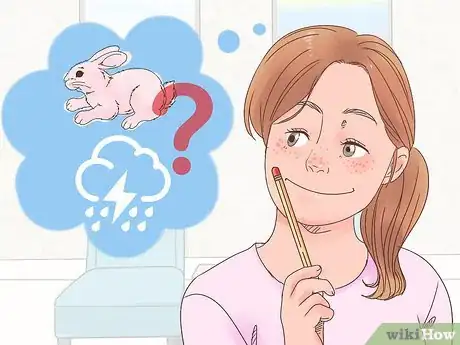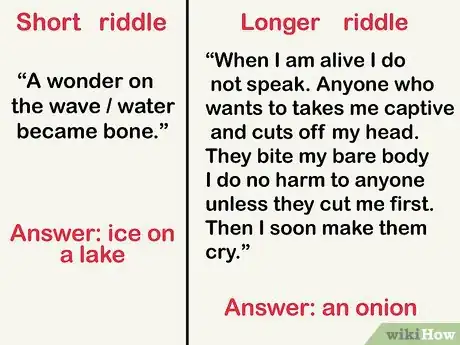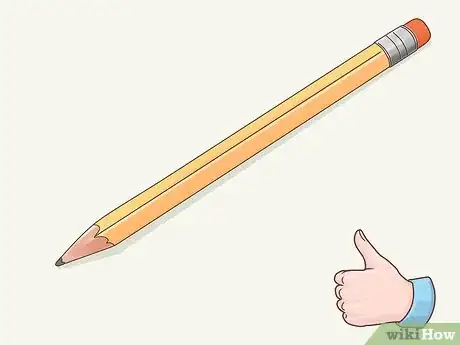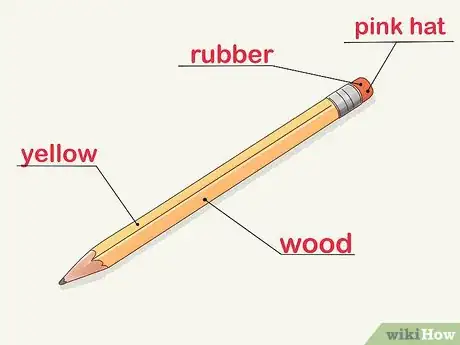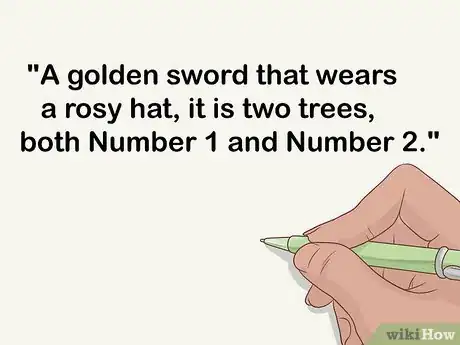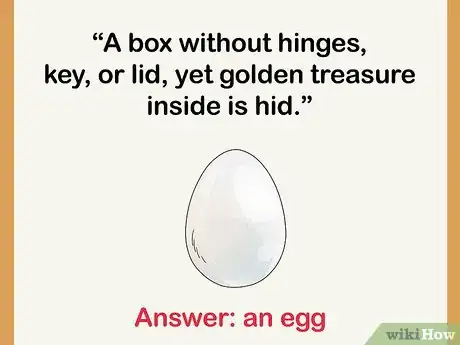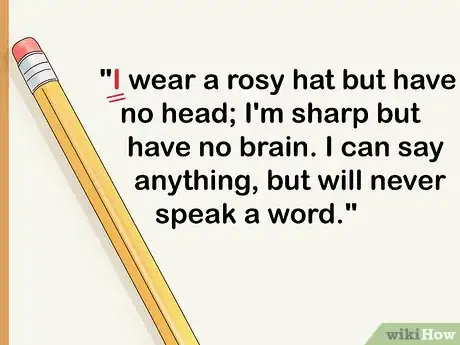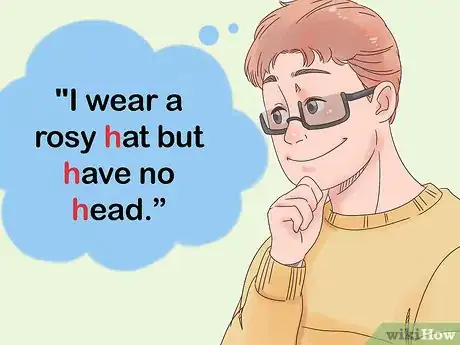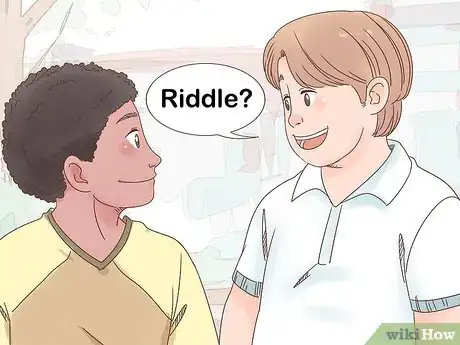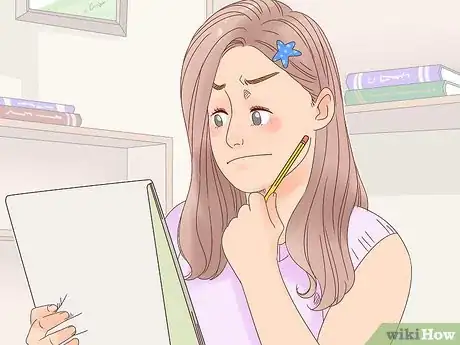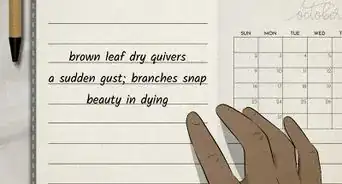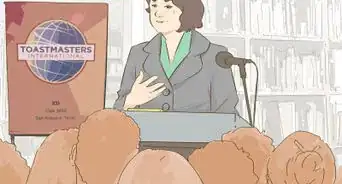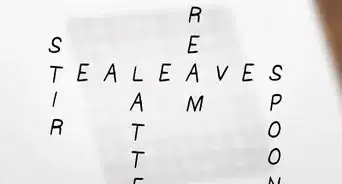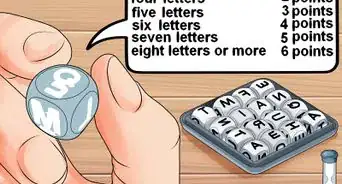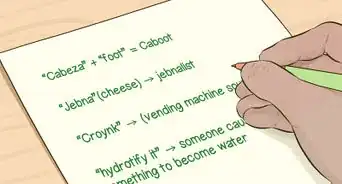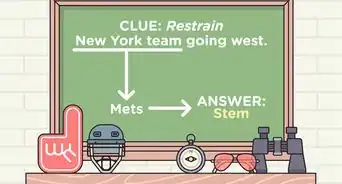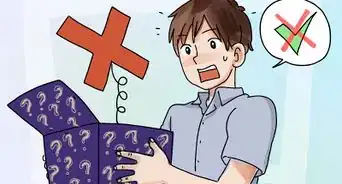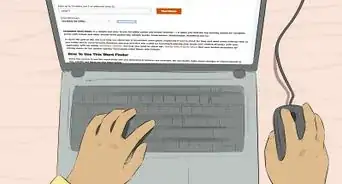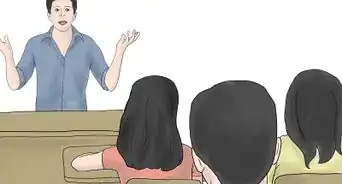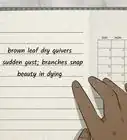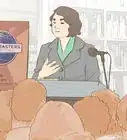wikiHow is a “wiki,” similar to Wikipedia, which means that many of our articles are co-written by multiple authors. To create this article, 59 people, some anonymous, worked to edit and improve it over time.
wikiHow marks an article as reader-approved once it receives enough positive feedback. In this case, several readers have written to tell us that this article was helpful to them, earning it our reader-approved status.
This article has been viewed 436,263 times.
Learn more...
People have told riddles for thousands of years. Riddles are fun to tell and even more fun to solve! You can make up your own personal riddles to share with friends and family.
Steps
Preparing to Make Up a Riddle
-
1Read a lot of riddles. Reading a variety of riddles will help you understand how a riddle works. There are many books of riddles available, or you can find some online.
- Many cultures have riddle traditions. Viking and Anglo-Saxon riddles are still very popular with English speakers, even though they were first told more than a thousand years ago! These riddles often have simple solutions such as “key” or “onion,” but are told in a creative way. You can find many collections online.[1]
- Riddles are also quite popular in modern fantasy literature, movies, and TV. J.R.R. Tolkien’s book The Hobbit has a whole chapter devoted to “Riddles in the Dark” told between two characters.
-
2Decide the subject of your riddle. Riddles can be about anything you can imagine, but physical objects that people are familiar with are very, very common topics.
- Other topics are natural phenomena like a storm or snow, an animal, or an action.
- Avoid topics that are very abstract or require specialized knowledge.
Advertisement -
3Determine how long you want your riddle to be. Some riddles are very short, just a phrase or two, while others are more like a miniature story. You can make your riddle to be any length you want, but it shouldn’t be so long that your audience can’t follow it.
- Here is an example of a very short riddle from the Anglo-Saxon ‘’Book of Exeter’’, written in the 900s AD: “A wonder on the wave / water became bone.” (Answer: ice on a lake.)
- Here is an example of a longer riddle from the Book of Exeter: “When I am alive I do not speak. / Anyone who wants to takes me captive and cuts off my head. / They bite my bare body / I do no harm to anyone unless they cut me first. / Then I soon make them cry.” (Answer: an onion.)
Creating Your Riddle
-
1Begin with the answer. Once you have the solution of of your riddle, you will work backward to creating the riddle. Try to choose something easy to personify, as personification (the ascription of human-like qualities to non-human things) is a very common technique in riddle-making.
- For example, you could choose "a pencil" as your solution, because most people will be familiar with it.
-
2Think of the things your answer does and what they look like. Compile these ideas in a list. Try to think of verbs and adjectives, in particular. Think of synonyms with multiple meanings and write them down.
- For "pencil," some items for your list could include: "No. 2" (the most common type of writing pencil)[2] ), "wood," "rubber," "yellow," "pink hat" (the eraser), "looks like the letter 'l' or the number '1'" (physical aspects of the pencil's shape).
- You could also include other aspects of your pencil: for example, it needs to be sharpened as it writes which means it will get shorter over time the more it's used (a possible paradox).
- Another common trick is to think of things your item can do: for example, a pencil is small but contains all things (because you can write "all things" with a pencil).
-
3Draft your riddle. Riddles use metaphors to describe familiar things in unfamiliar ways. Think about the list of ideas you created in the last step. If your solution is “pencil,” think of words you could use to create a metaphorical description: “hand-stick” or “yellow sword” are fanciful, but still offer clues to the solution.
- Here is a riddle that uses metaphor to describe a pencil: "A golden sword that wears a rosy hat, it is two trees, both Number 1 and Number 2."
- The pencil is a "sword" because it is pointed sharply at one end. This description also plays with the common saying, "The pen is mightier than the sword," and may help provide a clue. The "rosy hat" refers to the eraser.
- The "two trees" are cedar (the most common type of wood used for pencils),[3] and rubber (the type of tree that produces rubber for erasers).
- The pencil looks like the numeral "1" but is actually a "#2" pencil. This description is a double pun, because the #2 pencil is actually the most common, or "number one," type of pencil.
-
4Use simple, strong words. Riddles were originally a form of oral literature, rather than written down, so think of how the riddle sounds when you say it. Try not to bog down your riddle with elaborate words or abstract concepts.
- For example, a simply worded riddle involving a pencil could be: "This thing is small but contains all things; the longer it goes, the shorter it gets."
- Here is an example of a famous riddle from The Hobbit that uses simple, descriptive language: “A box without hinges, key, or lid, / Yet golden treasure inside is hid.” (Answer: an egg.)
-
5Personify your solution. Another way to make a catchy riddle is to write it as though your solution (the answer to the riddle) is speaking about itself. Start the riddle with “I” and a verb.
- For example, this riddle about a pencil uses personification as well as metaphor: "I wear a rosy hat but have no head; I'm sharp but have no brain. I can say anything, but will never speak a word."
-
6Think about how your riddle sounds. Because riddles are often shared orally, paying attention to how the language sounds will help you make a better riddle. Techniques such as alliteration (using the same letter sounds throughout the riddle) and rhyme help make it easier to tell and listen to your riddle.
- For example, "I wear a rosy hat but have no head" uses "h" to create a pleasing alliteration.
- Here is a very poetic riddle whose solution is a common tool: “I drink the blood of the Earth, / and the trees fear my roar, / yet a man may hold me in his hands.” (Answer: a chainsaw.)[4]
- Sometimes riddles also use “kennings,” which are poetic, figurative descriptions of something simple -- a riddle within a riddle! In the above riddle, the “blood of the Earth” is gas, which a chainsaw uses for power.[5] This was a very common technique in Viking riddles.
-
7Share your riddle with friends. The best way to know if the riddle you’ve made works is to share it with your friends and family and ask them to guess the answer. Sharing your riddles with family and friends may even convince them to make up riddles of their own!
-
8Revise your riddle, if necessary. If your friends and family guess the answer immediately, you may want to go back and make the riddle a little more metaphorical. If they have too much trouble guessing the answer, you may need to tweak the wording to make the answer more evident.
Community Q&A
-
QuestionHow to make a riddle for the answer "tree"?
 Community AnswerMy feet are long, and I have green hair. My favorite color is brown, and that's all I wear. Who am I?
Community AnswerMy feet are long, and I have green hair. My favorite color is brown, and that's all I wear. Who am I? -
QuestionHere's a tricky riddle: What goes up but never comes down?
 Community AnswerYour age!
Community AnswerYour age! -
QuestionMary's dad has five daughters. Tina, Lina, Lilo, and Nina. Who is the fifth?
 Community AnswerIt is Mary. Tina, Lina, Lilo, and Nina are her sisters, they have the same dad.
Community AnswerIt is Mary. Tina, Lina, Lilo, and Nina are her sisters, they have the same dad.
Things You'll Need
- A piece of paper
- Rhyming dictionary (optional)
- A thesaurus
- A pen
References
About This Article
To make up your own riddle, first choose a simple subject for your riddle, like an object or your favorite animal. The subject you choose will be the answer to your riddle. Next, come up with words that are associated with the answer. For example, if the answer to your riddle is "a pencil," you could come up with words like "wood," "rubber," and "yellow." Finally, put together clues based on the words you came up with. For example, your clue might look something like, "I'm made out of wood, I'm very sharp, and I wear a pink hat made out of rubber. What am I?" For tips on how to choose a good subject for your riddle, keep reading!
